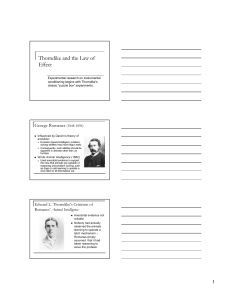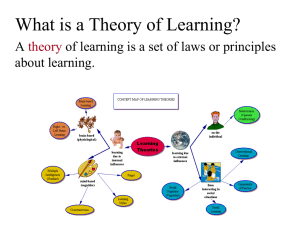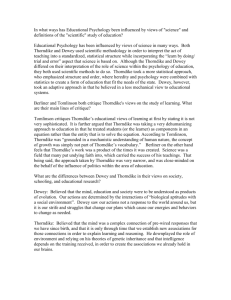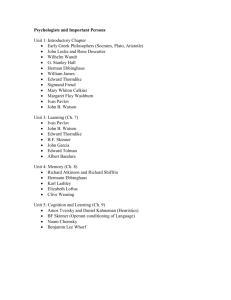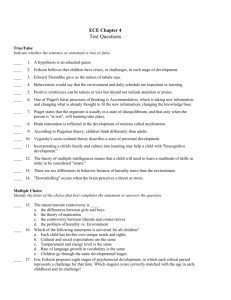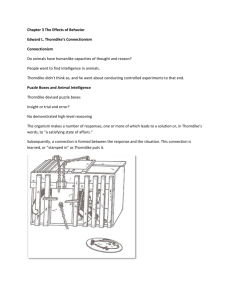- 407-91sum12
advertisement
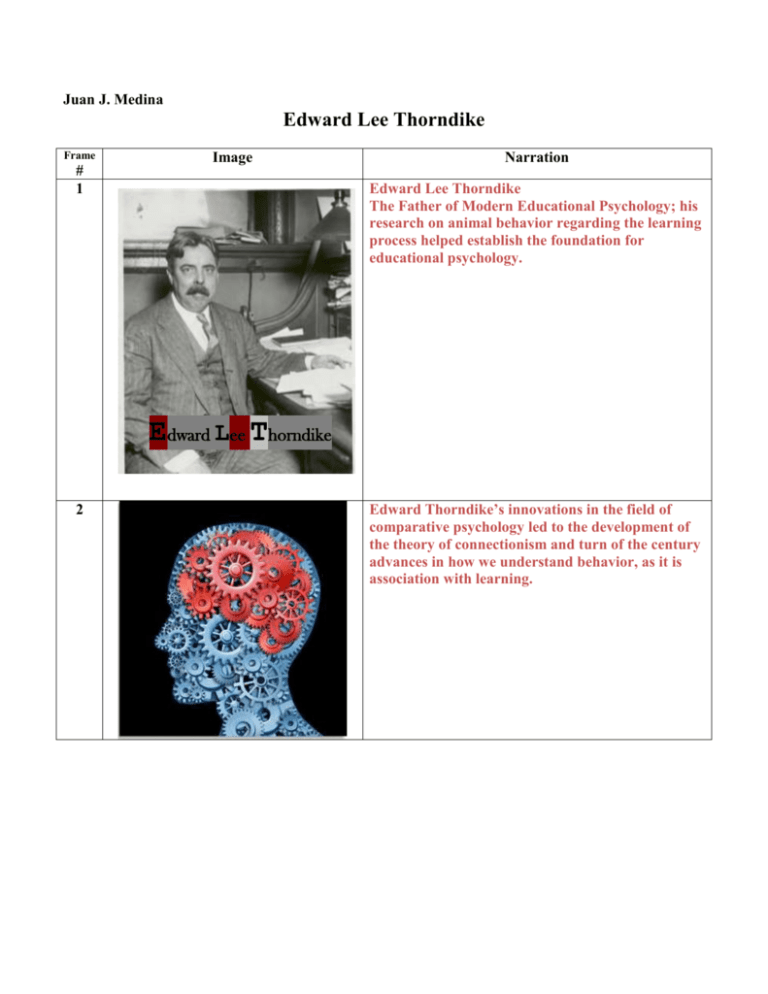
Juan J. Medina Edward Lee Thorndike Frame # 1 Image Narration Edward Lee Thorndike The Father of Modern Educational Psychology; his research on animal behavior regarding the learning process helped establish the foundation for educational psychology. Edward Lee Thorndike 2 Edward Thorndike’s innovations in the field of comparative psychology led to the development of the theory of connectionism and turn of the century advances in how we understand behavior, as it is association with learning. 3 Edward Lee Thorndike was borne to the family of a Methodist Minister in Lowell, Massachusetts in 1874 4 Born into an age of shifting foundations, where agrarian antecedents were being replaced with mechanical prowess. 5 In 1898 he completed his Doctorate with his thesis on Animal Intelligence that established his then controversial Law of Effect. 6 One year after receiving his Doctorate, Thorndike joined the Teachers College at Columbia University as a psychology professor where he remained for the rest of his career. 7 Interesting to note that Thorndike was a contemporary of Pavlov and Watson, but is less known mainly to due to the fact that much of what he developed was later associated with B. F. Skinner. 8 In 1912, he was elected president of the American Psychological Association. 9 In 1934, Thorndike became the head of the American Association for the Advancement of Science. Retiring only five years later in 1939. 10 1949 Thorndike died, having published over 500 books and articles, leaving a legacy that framed the principles of learning theory. 11 Thorndike's Theory of Learning could be distilled into a few key principles that still hold to our current understanding of cognitive psychology. They are as follows: Trial and error is the most basic type of learning. Learning in its purest form is incremental. Learning is not bound by ideas. All animals learn in the same manner. These basic principles are distilled from Thorndike’s Laws of Readiness, Exercise, and Effect. 13 Thorndike’s Laws of Readiness suggests, that interference with goal-directed behaviors will result in frustration. So 12 Frustrated Also, causing an action that is not desired will also result in frustration. 14 Thorndike’s Laws of Exercise asserts that we simply learn best by doing [law of use]. It also suggests that learning is lost when practice is not present, although to a lesser degree [law of disuse]. 15 Thorndike’s Laws of Effect is perhaps his most important work regarding learning. The Law of Effect states that behavior that is followed by a positive consequence is likely to be repeated; conversely, any behavior followed by a negative consequence is likely to be abandoned. 16 Thorndike came to this understanding of learning through a series of experiments conducted on cats by placing them in a “puzzle box” [I like that part] and encouraged the cat to escape by installing fish outside of the box [this is where he lost me]. 17 Cat in the box video iframe width="960" height="720" src="http://www.youtube.com/embed/fanm-WyQJo?rel=0" frameborder="0" allowfullscreen></iframe> 18 Thorndike found, that the cat’s escape time was reduced, as the cat became familiar with the positive reinforcement outside of the box in conjunction with discovering the means to egress outward. 19 If this seems familiar to the tune of operant conditioning, you are right! B. F. Skinner’s framework for operant conditioning that describes reinforcement as central in modifying behavior rests on theoretical and empirical foundations established by Edward Thorndike. 21 TheBigBang Theory!*!*! 20 Operant conditioning Big Bang Theory <iframe width="1280" height="720" src="https://www.youtube.com/embed/qy_mIEnnlF 4?rel=0" frameborder="0" allowfullscreen></iframe> Whereas classical conditioning depends on developing associations between events, Skinner’s operant conditioning involves learning from the consequences of our behavior. Skinner believed that behavior could be fully understood in terms of environmental cues and results. Penny learned that being agreeable to Sheldon results in earning a treat. 22 According to Lefrancois, (1972) “Thorndike's work is often called connectionism, because of the idea that bonds between stimulus and response take the form of neural connections. Learning involves the "stamping in" of connections, forgetting involves "stamping out" connections.” 23 One might consider if and how his theory of learning aligns with behavioral modification systems used in educational settings? 24 Behavioral modification systems in educational settings aim to control the verbal or physical input as a means to generate an improved or desired behavior. This is called replacement behavior. 25 Also, we should look at the antecedents and consequences of behavior in the educational setting. As more often than not, antecedents set the stage for negative behavioral responses exhibited at school. One of my personal fictional favorite negative consequences was Despicable Me’s Box of Shame 26 27 Much later, Albert Bandura asked us to consider behavior as learned, through social imitation and copying. As educators, we need to consider antecedents when we develop plans for replacing negative behaviors. The home is a powerful learning place, whether or not the learning is positive. Bobo-doll Bandura video <iframe width="960" height="720" src="http://www.youtube.com/embed/hHHdovKH DNU?rel=0" frameborder="0" allowfullscreen></iframe> To recap the works of Thorndike, all laws regarding learning are connected. The Law of Effect stated that the responses are linked to positive or negative rewards. Connected to the Law of Effect is The law of Recency, which asserts that the most recent response is likely to be repeated. The law of exercise asserts that associations between an action and an effect are supported through repetition. 28 Refrences Bandura, A. (1961). Transmission of aggression through imitation of aggressive models. The Journal of abnormal and social psychology, 63(3), 575. Lefrancois, 1972) Kearsley, G. (n.d.) Connectionism (E. Thorndike). Retrieved June 9, /2012 from http://tip.psychology.org/thorn.html Leahey, Thomas H. A History of Psychology, (New Jersey: Englewood Cliffs, 1992) McLeod, S. A. (2007). Simply Psychology; Edward Thorndike. Retrieved from http://www.simplypsychology.org/edwardthorndike.html Thorndike, E L. (1999). Education psychology. [electronic resource] : Briefer course. In Education psychology [electronic resource]: Briefer course / edward l. thorndike. Thorndike, E L. (2000). Animal intelligence: Experimental studies. In Animal intelligence. Transaction Publishers. "Thorndike, Edward Lee 1874-1949." American Decades. 2001. Retrieved June 14, 2012 from Encyclopedia.com: http://www.encyclopedia.com/doc/1G23468300083.html 29 Frame 1 2 3 4 5 6 7 8 9 10 11 12 13 14 15 16 17 18 19 20 21 22 23 24 25 26 Van Wagner, K. (2010), The Rise of Behaviorism, http://psychology.about.com/od/historyofpsychology/a/ psychistory_3.htm Image References http://www.psicoterapiainteractiva.com http://www.psychologycareerzone.com/images/dreamstime_xs_20 234708.jpg http://forgottennewengland.files.wordpress.com/2012/04/lowellmass-jail1.jpg http://muslimmedianetwork.com/mmn/?tag=money-economy http://www.nature.com/naturejobs/2006/060525/images/nj7092544a-i1.0.jpg http://www.psicoterapiainteractiva.com http://behaviorismbfskinnerjbwatsonipavlov.weebly.com/index.ht ml http://www.truthwinsout.org/wpcontent/uploads/2009/08/APAlogo.jpeg http://images.mises.org/DailyArticleBigImages/4607.jpg http://2.bp.blogspot.com/_ZACU6NT_J_c/R8xRKH8rlmI/AAAA AAAAAEI/JF0sPbzbmEs/s320/thorndike.jpg http://farm3.static.flickr.com/2761/4264798634_1e544b9e42.jpg http://www.proprofs.com/flashcards/cardshowall.php?title=grepsychology-theorists http://theeconomiccollapseblog.com/wpcontent/uploads/2010/07/Frustration.jpg http://www.cartoonstock.com/newscartoons/cartoonists/mba/lowr es/mban857l.jpg http://artofcoachingspeed.com/wpcontent/uploads/2011/07/Carrot_Stick_turtle-271x300.jpg http://www.simplypsychology.org/edward-thorndike.html http://comicadze.com/thumbnails/large_Cat_in_a_Box_Funny_Pi cture_52635.jpg https://wikispaces.psu.edu/download/attachments/40050309/Puzzl e_box.jpg http://earjbio.wikispaces.com/file/view/T046260a.gif/34009065/T 046260a.gif http://theislamicevidence.webs.com/3disprovingdarwinism.htm http://s2.hubimg.com/u/5251353_f520.jpg http://www.mind.ilstu.edu/curriculum/connectionism_intro/imgs/ PDP_J.JPG http://www.wiu.k12.pa.us/cms/lib6/PA14000132/Centricity/Doma in/12/classroom2.jpg https://bestuniversalscreening.com/content/img/wheel.jpg http://fightinginsanity.files.wordpress.com/2011/11/box-ofshame.jpg http://students.cis.uab.edu/sarahlr/bobo%20doll.jpg 27 28 http://www.scoop.it/t/5e-s-learning http://www.mesotheliomalawyersblog.com/2012/01/psychological-treatment-in-mes.html
